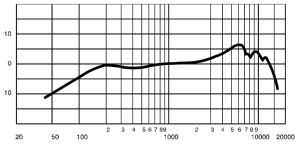This fortnight Anna Laverty gave a small guest lecture at SAE and left us with a microphone list from her typical setup at Sing Sing Studios.
While “anything works” I thought it would be a good idea to research these microphones to widen my understanding of the toolkit available to sound engineers, as well as to look for commonly used microphones and their ideal applications.
Beyerdynamic M 88 TG -Dynamic Hypercardioid mic featuring soft presence boost and exceptional bass reproduction.
Neumann U 47 FET – Combining the capsule sound of its predecessor the K 47 & U 47 with the ability to record high SPL sources such as loud guitar amplifiers, bass cabs, and bass drums. The microphone features a bass roll off around 140Hz and two different attenuation stages at 6dB and 10dB.
Shure SM7B – The dynamic coil is similar to the Unidyne III in 57/58s. The microphone features both a bass roll off at 400Hz and a presence boost at 2-4kHz. The mic has very low sensitivity meaning that it does not work well on quiet sound sources. This also means that pre-amps allowing for large amounts of transparent/clean
gain work well with this microphone.
Shure SM57 – Industry standard highly versatile dynamic microphone. Frequency range tapers off after 15kHz which is supplemented by boosting the presence region making the mic perfect for guitars. The studio microphone 57 is also one of the most robust microphones available, both in terms of handling SPL and overall build making it a key piece in the live sound kit.
Sennheiser MD421 – 30Hz-17kHz. Features a 5 position bass roll off switch which allows for the control of the proximity effect in close micing situations, and a presence boost.
Sennheiser 441- Supercardioid polar pattern and a 30Hz-20kHz frequency response. Features a similar bass roll off switch to the 421, and a brilliance switch which accentuates the higher frequencies by lowering everything below 2kHz and boosting everything above. The 441 is known as one of the most accurate and versatile dynamic microphones on the market.
Neumann KM 84 – 40Hz – 20kHz. The worlds first phantom powered (48v) microphone. Has also become the standard by which pencil condensers are measured. The KM 84 maintains its frequency response +/- 135 degrees to the centre of the microphone allowing the microphone to retain much of its off-axis frequency response.

Coles 4038 – 30Hz -15kHz linear frequency response. Ribbon microphone with the standard figure 8 polar pattern. Originally designed by the BBC to work as a broadcast microphone to be used in situations where clear smooth wide range frequency response, absent of transient distortion and relatively high sensitivity was essential.

Neumann U 89 – 40Hz – 18kHz linear frequency response. Features 5 interchangeable polar patterns including Omni-Directional, Wide Angle Cardioid, Cardioid, Hypercardioid, and Figure 8. The microphone also features a 3dB bass roll off switch allowing a choice between either 80Hz or 160Hz.

AKG C414 – There are two modern iterations of the C414, the XL II and the XLS which differ only in frequency response and capsule. The XL II has a more pronounced presence boost lending itself to vocals where as the XLS flatter frequency response leans more towards instrument recording.

AEA R92 – 20Hz – 20Khz frequency response. Standard ribbon figure 8 polar pattern. Can handle high SPL levels for a ribbon microphone with a max SPL of 165dBSPL (can be put to the grill of a guitar amplifier).







